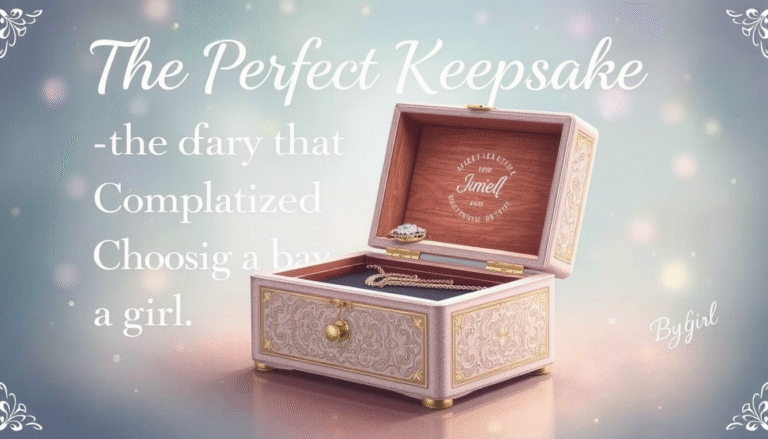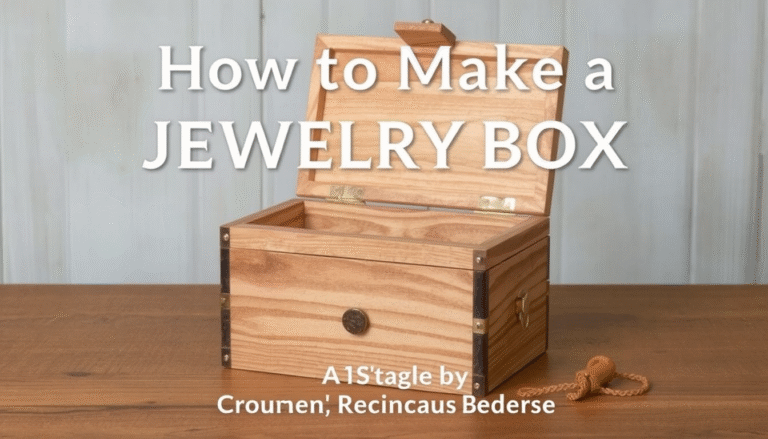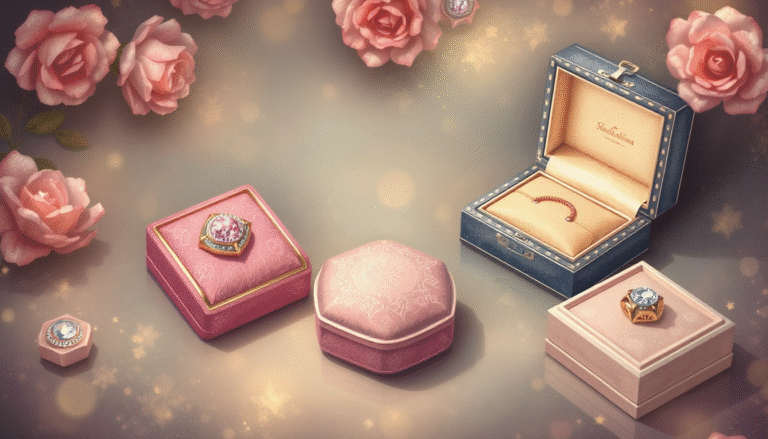An antique Chinese jewelry box is not just a simple container for treasures at all, but it also holds history, showcases intricate artistry, and tells the story of dynasties from long ago. Whether you inherited it from your family or you are starting to collect, the item you hold creates a connection between you and a rich cultural legacy.
It’s not enough to just have a quick glance at it to know what it is. You have to get underneath the surface and see through the materials, craftsmanship, and symbolism that make these objects so special.
This guide is the roadmap, telling you the steps to take. We will identify the features that can help you identify a genuine antique piece from a contemporary one. We will discover the historical styles that affected their design. We will interpret the concealed meanings in their embellishment. Together, we will reveal all the tricks of your chinese jewelry box antique and figure out how to maintain its beauty for years ahead.
The Marks of Authenticity
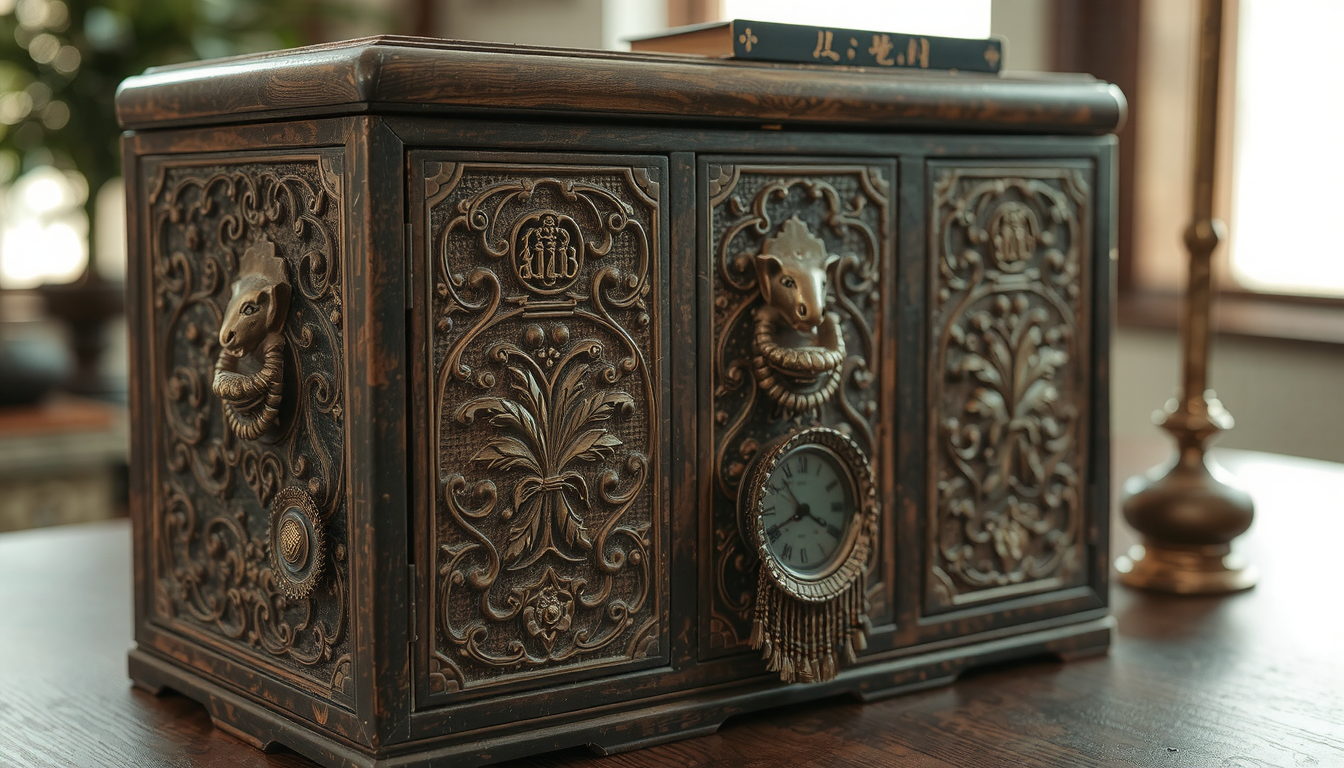 To start our adventure, we have to learn how to communicate with these beautiful things. The first skill any collector needs is to know the marks of a real antique Chinese jewelry box. It is to develop a keen eye that notices the slight difference in age, materials, and construction.
To start our adventure, we have to learn how to communicate with these beautiful things. The first skill any collector needs is to know the marks of a real antique Chinese jewelry box. It is to develop a keen eye that notices the slight difference in age, materials, and construction.
Dating Distinctions
What looks like a very old box is not necessarily a real antique. The period of time has an important role.
-
Antique: Generally, a piece is called an antique if it is over 100 years old. Typically, a chinese jewelry box antique is from the Qing Dynasty or older. Such artifacts have hand-tooling, organic materials, and construction techniques used back then.
-
Vintage: This term is applied to items between the ages of 50 and 99 years old. A vintage Chinese jewelry box could be from the mid-20th century. It is likely to feature a mixture of traditional motifs with materials and production methods that were common after World War II.
-
Reproduction: These are new items made to look like old styles. They are usually mass-produced. You can find them through their machine-cut precision, modern hardware, and artificially distressed finishes.
Main Materials and Artistry
The spirit of an antique box resides in its materials and the people who worked with them.
-
Wood: Look for heavy, solid woods. Camphor is notable for its fragrant, insect-repelling characteristics. Zitan (a kind of rosewood) and Huanghuali are rare woods reserved for high-status items. Natural aging will cause a deep, warm patina and perhaps some shrinkage cracks along the grain, not random sanding marks.
-
Lacquerware: A true antique lacquer is deep, shiny, and has a finish built up in many layers of thin film. It has a warmth and depth that cannot be achieved with modern paint or varnish. It might show some age-related fine crazing, which is just a thin web of cracks on the surface.
-
Inlays: Traditional decoration often included complicated inlays. Common materials for this were finely cut mother-of-pearl, carved soapstone, and polished jade. Pay attention to little imperfections that show that someone cut and placed by hand instead of the machine work that is super precise.
-
Hardware: Metal hardware is a vital clue. Real hardware is mostly handmade and made of brass or bronze. Clasps, hinges, and handles will feel heavy and have a natural dark patina that developed over time. They won’t be shiny, light, nor will they be held with modern Phillips-head screws.
A Dynasty Journey
The design of a Chinese jewelry box is a direct reflection of the period in which it was made. Dynasties came and went, and so did artforms and skills, leaving their indelible marks on decorative arts.

Ming Dynasty (1368–1644)
The Ming design philosophy revered simplicity and geometrical purity. Thus, the jewelry boxes of this era are characterized by pure lines, perfect proportions, and a focus on the wood’s natural beauty. They were often left undecorated, which was an excellent way to allow the quality of the wood and the precision of the joinery to come forward.
Qing Dynasty (1644–1912)
This was the remarkable period for decorative arts in China. The majority of the antiques still existing come from this long and fruitful time. The Qing style is characterized by surplus and elaborate designs. Artisans embraced complexity, with beautiful carvings, animated, multi-colored lacquer pictures, and detailed inlays. These are the luxe lacquer and inlay jewelry boxes that many people initially think of when hearing about a classic antique.
Republic Era (1912-1949)
Artisans still continued to craft boxes in the old traditions even after the Qing Dynasty’s fall, but the influence of the West became more and more noticeable. Whereas many of the works of this period looked like late Qing ones, a few of them include Art Deco lines or different shades. It was a time of cultural evolution.
The Collector’s Eye: True or Imitation?
 The most important skill of all for a collector is to be able to tell an authentic antique from a well-faked one. Nowadays, some reproductions come so close to the original that they can be easily misidentified. But under a closer inspection, they will almost always give themselves away. This knowledge is essential for getting to know not only the story of your piece but also its worth.
The most important skill of all for a collector is to be able to tell an authentic antique from a well-faked one. Nowadays, some reproductions come so close to the original that they can be easily misidentified. But under a closer inspection, they will almost always give themselves away. This knowledge is essential for getting to know not only the story of your piece but also its worth.
Our experience and expertise lead us to look for the clues that our hands and senses give us. Run your fingers along the joints. A true antique often has seamless but not perfectly machine-smooth dovetails. Feel the weight. Older woods like Zitan are typically dense and substantial.
For a more detailed comparison, a checklist approach is essential for Telling real wooden antiques from China apart from reproductions.
| Genuine Antique Signs | Reproduction Warning Signs |
|---|---|
| Construction: Hand-cut dovetail or mortise-and-tenon joints. Minimal mismatches exhibit the touch of a human hand. | Construction: Modern glues, staples, or Phillips-head screws. Machine-cut perfect symmetry. |
| Hardware: Heavy, hand-forged brass or bronze with a deep, uneven, naturally formed patina. Original lock and key. | Hardware: Lightweight, shiny, or chemically aged brass with a uniform color. Standardized, modern lock mechanisms. |
| Wood & Finish: Deep, warm patina from decades of handling. Honest wear at touchpoints (corners, latch). Shrinkage. | Wood & Finish: Artificial distressing (random sanding, gouges). A harsh chemical smell from modern stains. |
| Smell: A faint, pleasant scent of old wood, camphor, or natural lacquer. | Smell: A strong odor of chemicals, varnish, or glue. |
| Weight: Often feels heavy and dense for its size because of the quality of aged hardwood. | Weight: Can feel surprisingly light due to the use of cheaper, faster-growing wood or composite materials. |
Reading the Story: Symbolism Guide
A Chinese jewelry box usually serves as more than simple decoration. It is a tapestry of auspicious symbols, each offering good luck and carrying specific meanings and blessings. Interpreting this visual language transforms the box from a beautiful item into a meaningful narrative.
Here are some of the most recurrent symbols and their meanings:
- Dragon & Phoenix: The ultimate pairing, representing the Emperor and the Empress. Together, they embody the perfect harmony of a married couple and good fortune.
- Bats (Fu 蝠): The word for bat sounds identical to the word for good fortune (Fu 福). A design with five bats is particularly auspicious, representing the Five Blessings: longevity, wealth, health, love of virtue, and a peaceful death.
- Peonies: Known as the “king of flowers,” the peony symbolizes wealth, prosperity, high social status, and feminine beauty.
- Lotus: Rising untainted from muddy waters, the lotus flower is a profound symbol of purity, spiritual enlightenment, and detachment from worldly troubles.
- Cranes or Peaches: Both are powerful symbols of longevity and immortality. They often appear in scenes related to Taoist legends.
- “Double Happiness” Symbol (囍): This character is a ligature of two “happiness” characters joined together. It is used almost exclusively for marriage, representing conjugal joy and bliss.
Keeping the Tradition Alive: Caring and Cleaning
Taking proper care is the best way to protect your antique box’s value and beauty. Harsh modern cleaning products can result in permanent damage in minutes. The golden rule is to always use the gentlest method possible.
We’ve witnessed stunning lacquered finishes ruined by a single application of a modern spray polish. The cardinal rule is always to apply the gentlest method first. Start with simple dry dusting.
The “Dos” of Antique Box Care
- Dusting: Use a clean, dry, soft microfiber cloth or a natural-bristle artist’s brush to gently remove surface dust.
- Cleaning: If the box is grimy, slightly dampen a soft cloth with distilled water and a tiny drop of pH-neutral soap. Wring it out thoroughly until it’s almost dry. Always test on a small, inconspicuous area first.
- Environment: Keep your box in a stable environment. Avoid direct sunlight, which fades colors and damages lacquer. Stay away from heat sources like radiators or vents that cause rapid changes in temperature and humidity.
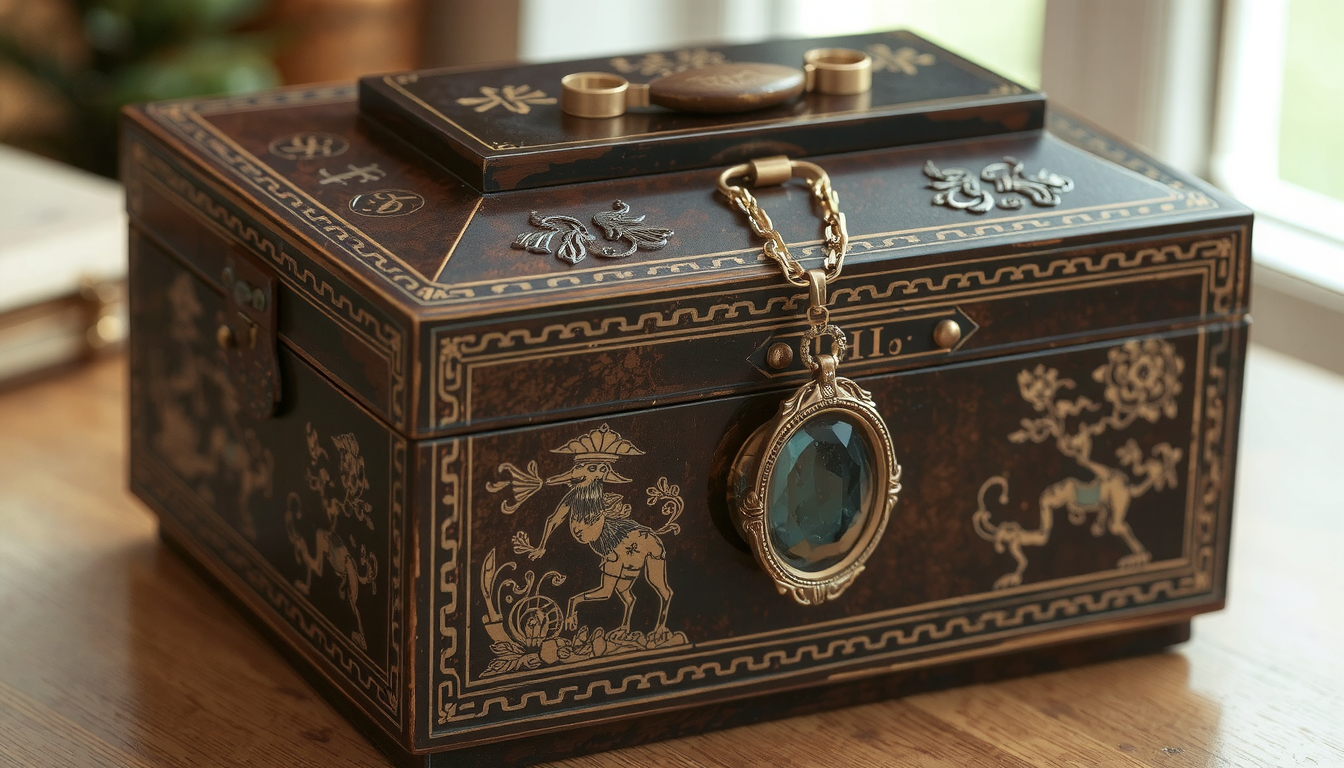
The “Don’ts” of Antique Box Care
- NEVER use commercial furniture polish, waxes, oils, or any product that contains silicone or solvents. These chemicals can penetrate and dissolve antique finishes.
- DO NOT submerge the box in water or overwet the surface. This can cause wood to swell and lift fragile inlays or lacquer.
- AVOID placing heavy objects on top of the box. This can stress the construction and damage the lid.
Finding & Valuing Your Treasure
Whether you are looking for an item to buy or want to know the real value of one you own, knowing where to look is a must.
Where to Find an Antique Box
The most reliable sources are reputable antique dealers who specialize in Asian art. Established auction houses and vetted online marketplaces are also good options. Browsing through selections from specialty retailers that deal with Asian jewelry boxes can give you a general idea of the styles and price ranges available.
Getting an Appraisal
To know the monetary value of your chinese jewelry box antique, we highly recommend visiting a certified appraiser. Make sure they have documented knowledge in Chinese antiques. They can provide a formal assessment you can use for either insurance or resale purposes.
Inspired by the Past: Contemporary Choices
If you admire the beauty of the chinese jewelry box antique but prefer modern furniture that is functional and durable, a great option is to search for high-quality contemporary models. You can find a curated selection of expertly crafted jewelry boxes at Jewelry Box Supplier Ltd.
Frequently Asked Questions (FAQ)
What is the most valuable type of antique Chinese jewelry box?
Value is a combination of age, rarity, material, craftsmanship, and condition. Generally, boxes made of rare woods such as Zitan or Huanghuali will be priced the highest. Those from an early dynasty like the Ming are also very valuable. Pieces with exceptionally fine jade inlays or Imperial-quality lacquer work are worth the most.
How can I tell if the jade on my box is real?
Authentic jade feels cool and smooth to the touch. It’s remarkably hard, so it shouldn’t be easily scratched by a steel knife. When gently tapped against another piece of jade, it produces a clear, musical tone. However, for a definitive identification, it’s best to consult a certified gemologist.
My box has a musty smell. How do I get rid of it?
First, air the box out by leaving it open in a dry, well-ventilated room, away from direct sunlight. To actively absorb odors, you can place a small, open container of baking soda or activated charcoal inside for several days. Never spray it with commercial air fresheners, as their chemicals can damage the wood and finish.
Are the brass fittings supposed to be shiny?
No. On a genuine antique, the brass hardware should have a deep, dark, and often uneven patina that develops naturally over a century or more. Bright, shiny brass is a common indicator of a reproduction or a sign that the original, valuable patina has been unfortunately polished away.
What is a Chinese wedding jewelry box?
A Chinese wedding jewelry box was a key part of a bride’s dowry. These are typically larger and more ornate than standard boxes, often decorated in auspicious red and gold lacquer. They are frequently adorned with powerful symbols of marital bliss, such as the “Double Happiness” character, dragons, and phoenixes.


